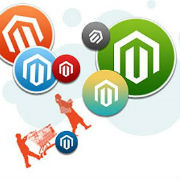
Magento and Shopify are popular e-Commerce solutions that power thousands of web shops worldwide. Nonetheless, they represent different shopping cart classes aimed to help different types of merchants. Magento is a free open source platform that is developed for technical-minded users while Shopify is a hosted and incredibly user-friendly cart aimed to fit non-techieque sellers.
Both shopping carts have their positive and negative sides. Magento (now Adobe Commerce) continues to be a powerful platform, supporting hundreds of thousands of online stores globally. It gained popularity because of top-end functionality, strong community support and virtually unlimited customization options. At the same time, Shopify is widely recognized for its simplicity, outstanding tech support, and comprehensive features, empowering millions of online businesses. As a result users claim Magento to be rather difficult to manage. That’s why some of them decide to migrate all the store data from Magento to Shopify, which is less complicated to use. In a few minutes, you will get acquainted with useful tips and find out how to avoid any issues during data transfer.

1. Store Customization
In a case, you have expanded Shopify’s functionality with a help of various extensions you may experience some issues during migration. So, you have to minimize your customizations and turn off all possible modules or plugins before migration started. It will decrease a possibility of incorrect work or discrepancy between extensions. You will be able to customize your Shopify store right after migration is complete.
2. Configurable Products

You have to remember that one Magento configurable product will be migrated to Shopify as several products. Consequently, quantity of entities will be bigger. For example, your Magento store has 97 products including 20 configurable. Due to how configurable products are handled in Shopify, the quantity of individual entities may be larger. As a result, there might be more products on your Shopify store than your initial simple product count suggests. So, you will have to choose a plan, which corresponds number of your products.

3. Product Names
Before you start migration, please check if there are products with empty name string on your Magento store. If there are some, it is highly recommended to set up a default product names. It will help you to avoid interruption while migration process.
So, now you know all the major tips, which will help to avoid any possible problems and perform successful Magento to Shopify migration so nothing can separate you from a desirable store. In case if you have any further questions concerning data migration feel free to contact Cart2Cart Support Team.
Monthly Update – December 2025
As we close out 2025 and look towards the new year, optimizing your e-commerce platform for peak performance and customer engagement remains paramount. December's focus for merchants undertaking migration, especially from a robust system like Magento to the agile Shopify, should be on fine-tuning their new environment. Post-migration, it's crucial to leverage Shopify's enhanced analytics to deeply understand customer behavior and refine conversion funnels. Consider implementing advanced personalization features, often available through Shopify apps, to create a tailored shopping experience that boosts loyalty and average order value. This month is also ideal for reviewing and updating your SEO strategy on the new platform, ensuring all redirects are functioning perfectly and new content is indexed efficiently by search engines. Embrace new integrations that streamline operations, from inventory management to customer service, allowing you to scale effectively into 2026. A smooth transition involves not just moving data, but strategically enhancing your new storefront for future growth.
For more details, explore our FAQ section or schedule a call with a migration expert.




